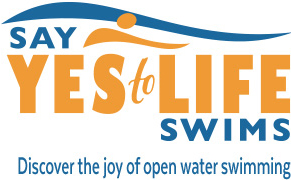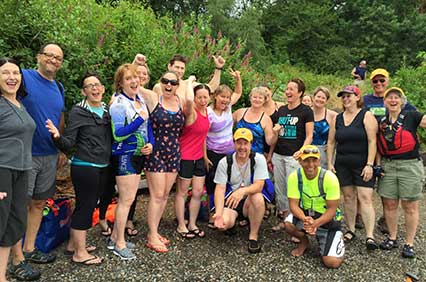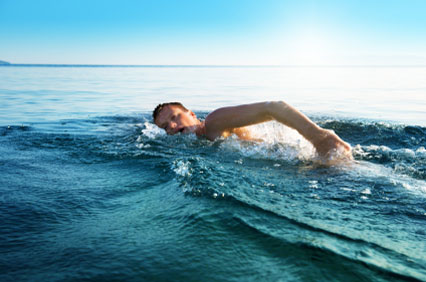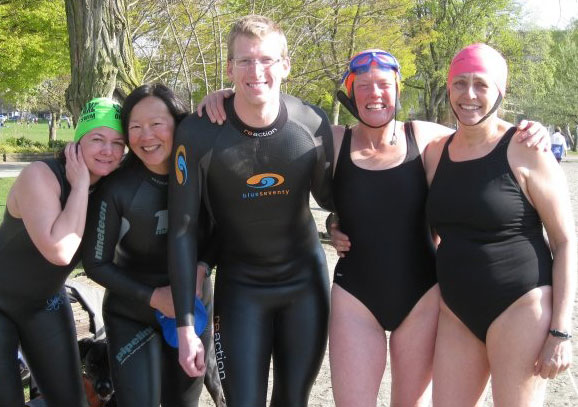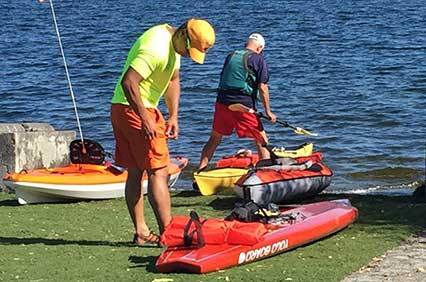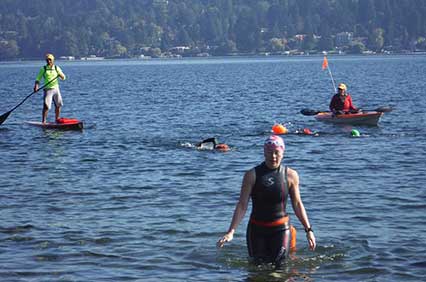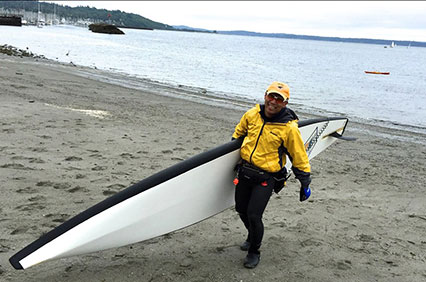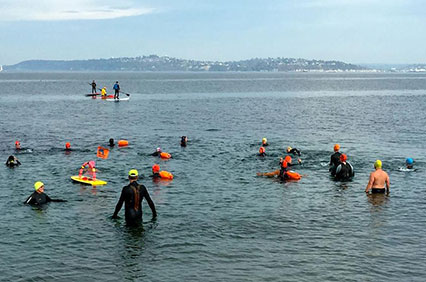December 18th, 2018For Geeks Only: Biomechanic Analysis of Freestyle’s Catch and Pull Phases
Introduction
I came to swimming later in life. All its aspects fascinated me, so I embarked on my own informal “adult learning project”, which continues through today. My project includes reading everything I can get my hands on, particularly about open water swimming, as well as interviewing swim teachers about their views, beliefs, and approaches.
“Swimming Doesn’t Come Naturally” to Humans
During my talks with swim and triathlon coaches, I hear a recurring theme. Many of them state that for humans, “swimming isn’t natural”. With the hope of assuaging new swimmers’ awkwardness, I have sometimes expressed this sentiment myself. Renowned author and lifeguard Frank Pia has written, “We are…ill-equipped in both movement and survival in the sea and lakes that consume the vast majority of our planet.”[1]
It’s true that the human form, with its powerful gluteal muscles, excels at running. Thanks to being primates, we’re also good climbers. In living our lives day-to-day, we primarily keep our bodies vertical, moving in the sagittal plane. In fact, drowning people typically keep their bodies vertical as they try to “climb” out of the water.[2]
The mysterious nature of water ignites a primeval fear in many of us. A 1998 Gallup poll found that 46% of American adults are afraid of deep water in pools, while the CDC estimates that 37% of adults cannot swim. [3
Busting the Myth: We Are Built to Swim!
However, these facts have little to do with the fact that our bodies are as designed to swim. People have been swimming since there were people on earth. Paintings dating to 2500 BCE depict people swimming in the River Nile (Figure 1), and the first recorded swimming races were held in 36 BC, in Japan. [4] The mammalian dive reflex (known as “our inner dolphin” and exploited by free divers) allows us to exist underwater for extended periods of time.
In recent years, swimming is receiving an explosion of interest, particularly by the aging population. Many baby boomers have discovered or re-discovered swimming as a challenging, yet non-weight-bearing exercise. [5] Swimming works the great majority of the muscles in the human body. [6] And, unlike many other “percussive” sports, people into their late 90’s are still able to exercise by swimming.
Lastly, open water swimming is enjoying a popular resurgence that it hasn’t experienced since the 1920’s, when Gertrude Ederly was the first woman to swim the English Channel, starting an open-water swimming craze. Currently, there are an estimated 25,000-30,000 organized open water events held annually around the world, and unprecedented solo swims and relays occur all over the globe. [7]
So, swimming is super-popular! And I’ve always been curious as to how it actually works. Specifically, what are the mechanics of the catch and pull phases of the freestyle stroke? That’s what I set out to discover in this paper.
Methods
My friend Carolyn kindly volunteered to be my subject. Carolyn is a recently retired, 65-year-old lifelong swimmer and swim coach. Two to three times a week, Carolyn swims approximately 2500-3000 yards in the pool. In recent years, she has also completed multiple open water swims of up to 7 kilometers in Lake Washington.
To gather data for this paper, I used my iPhone to video Carolyn at both Medgar Evers and Rainier Beach public pools in Seattle, Washington. Filming her underwater proved to be too much of a challenge, particularly during the pull phase when I would need to film her from below. Besides, I was interested in obtaining clear documentation of the mechanics of just her shoulder and arm, not her entire body.
Analysis and Breakdown of the Catch and Pull Phases
Overview: Bones and Muscle
Before describing the specific movements of the catch and pull phases, I’d like to provide a quick overview of the bones and muscles that freestyle uses. In general, freestyle stroke uses the bones and muscles of the shoulder girdle (clavicle and scapula) and arm (humerus, radius, and ulna). Most of the movements for the freestyle stroke also involve the glenohumeral joint, the ulnohumeral joint and radioulnar joint. The deltoid is the primary muscle involved in changing the position of the humerus, and thus the entire arm.
Unique Dynamics of the Freestyle Stroke
The freestyle stroke is one of constant, repetitive rotation. There is really no beginning or end to the movement, and the stroke truly involves the entire body. In this paper, I isolate and analyze the movement of just one arm during the catch and pull phases. The actions are the same for the opposite arm.
I am not going to describe the recovery portion of the freestyle stroke except to say that the same stabilizers (pectoralis minor, rhomboids, levator scapula, middle and lower trapezius, and the serratus anterior) work with the deltoid and rotator cuff to reposition the arm during that phase.
From my research, I found that the serratus anterior is active during all phases of the entire stroke, providing ongoing stability to every movement of the freestyle stroke. Elbow flexion and extension also occur throughout the entire stroke.
Purpose and Description of the Two Phases
Catch
- Purpose
To allow the hand, wrist, elbow and arm to enter the water and set up for a powerful pull.
- Description
Starting Position: The catch begins with the arm extended to its outer range in the superior transverse plane.
The scapula, in upward rotation, works together with the clavicular portion of the pectoralis major to begin the arm’s eccentric contraction. From this position, the upper trapezius helps to elevate the scapula while the rhomboids retract it. The shoulder joint medially rotates as the deltoid holds the upper arm high. The elbow flexors begin to slightly concentrically contract. The wrist flexors hold the wrist in a position of slight flexion.
Finally, the hand enters the water, fingertips first. (Figure 3).
In the shoulder, the agonists are the pectoralis major, subscapularis, latissimus dorsi, and teres major. The antagonists are the anterior deltoid, coracobrachialis, and biceps brachii, while the rotator cuff (infraspinatus, teres minor, supraspinatus, subscapularis) stabilizes the entire shoulder.
In the elbow, the agonists are the bicep, biceps bracchi, and brachialis, while the tricep acts as the antagonist.
Pull
- Purpose
To propel the swimmer forward. The pull, (or as Olympian Sheila Taormina describes it, “the diagonal motion toward the body”) is the stroke’s power phase.
- Description
Starting position: The pull phase begins in the anterior transverse plane. The full hand is submerged in the water, palm down and moving inferiorly.
The scapula depresses and the shoulder stays in its medial rotation as the elbow concentrically contracts into approximately 30 degrees of flexion. At this point, the arm is moving below the trunk of the body, pushing backwards on the water. The trapezius and latissimus dorsi adduct the flexed arm toward the midline. Wrist flexors hold the wrist in a position of slight flexion.
Where the power comes from: The wrist, forearm, and upper arm work together to comprise one half of a third-class lever, while the upper arm comprises the other half. The adduction of the bent arm (lever) in the sagittal plane under the body is what “holds” the water, applying backward force to move the body forward. (Figure 5)
The propulsive forces generated by the lever rely on the scapula’s having a firm base of support. The pectoralis minor, rhomboids, levator scapula, middle and lower trapezius, teres minor, and the serratus anterior work together to stabilize the scapula.
The clavicular portion of the pectoralis major and the latissimus dorsi generate the majority of force during the pull. The latissimus dorsi, pectoralis major (upper and lower fibers) deltoid anterior fibers, muscles of the rotator cuff, and the coracobrachialis act as agonists. The antagonists are the tricep and deltoid posterior fibers.
The pull finishes with the hand exiting the water in the posterior transverse plane, at the hip. The wrist is in full extension with palm facing inferiorly. The subscapularis, superior middle deltoids, and supraspinatus are the agonists, while the biceps are the antagonists.
Conclusion
The art of swimming is complex. It comprises multiple, simultaneous muscle movements. Contrary to widely-held beliefs and fears, swimming can be considered “natural” for the human body, and history shows us that humans have swum for thousands of years. Swimming is a skill that people of all ages, and many ability levels, can learn.
Understanding how the shoulder, arm and wrist work together during freestyle may help both novices and advanced swimmers improve their stroke.
I am an advocate for the joy of swimming. Alexandr Popov, one of the world’s fastest swimmers, describes swimming this way : “The water is your friend…you don’t have to fight with water, just share the same spirit as the water, and it will help you move.”
Books and Resources used for This Paper
Colwin CM. Breakthrough swimming. Champaign, IL: Human Kinetics. Retrieved from https://www.ncbi.nlm.nih.gov/pmc/articles/PMC3438875/
Kinesiology and biomechanics of the freestyle stroke (part one). Retrieved from https://www.underwateraudio.com/blogs/swimming-and-fitness-blog/kinesiology-biomechanics-freestyle-stroke
McLeod, I. (2010). Swimming Anatomy. Champaign, IL: Human Kinetics
Mortimer, G. (2008). The great swim. New York, NY: Walter & Company
Planes of movement. Retrieved from https://www.swimmingscience.net/swimming-science-resources/
Taormina, S. (2010). Swim speed secrets for swimmers and triathletes. Boulder, CO: Velo Press.
Tarpinian, S. (1996). The Essential Swimmer. Guilford, CT: Lyons Press
Tough, A. (1979). The adult’s learning projects: a fresh approach to theory and practice.
[1] Swimming: Is it Natural or Learned? Retrieved from Caveman World http://www.cavemenworld.com/explore/swimming-is-it-natural-or-learned/
[2] Recognizing Drowning, Retrieved from https://www.outdoorswimmingsociety.com/recognising-drowning/
[3] How Many Americans Can’t Swim? Retrieved from http://www.slate.com/articles/news_and_politics/explainer/2010/08/how_many_americans_cant_swim.html
[4] Swimming. Retrieved from https://www.encyclopedia.com/sports-and-everyday-life/sports/sports/swimming
[5] Aging Swim Lessons and the Benefits of Swimming in Later Life. Retrieved from https://bloomerboomer.com/aging-swim-lessons-and-benefits-of-swimming-in-later-life/
[6] Does Swimming Work Every Muscle? Retrieved from https://livehealthy.chron.com/swimming-work-muscle-3713.html
[7] A Voice for the Sport: Open Water Swim Explosion. Retrieved from https://www.swimmingworldmagazine.com/news/swimming-world-presents-a-voice-for-the-sport-open-water-explosion/)
